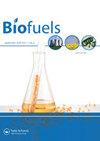超声强化工艺研究大西洋黄连木油作为生物柴油原料的潜力
IF 2.6
4区 工程技术
Q3 ENERGY & FUELS
引用次数: 0
摘要
摘要与生产生物柴油的原材料相关的成本是生物柴油最终价格的最决定性因素,因此设想了非食用、易于获得和廉价的原料。atlantica mutica(PAM)是伊朗丛林中富含石油且可大量利用的生物质,可被视为生产生物柴油的有前景的能源作物。它的种子含有30%的优质油脂。PAM油的脂肪酸分布富含16-18个碳链,与汽油-柴油的脂肪酸相似。研究了超声辅助工艺参数对PAM油生物柴油收率的影响。使用可旋转中心复合材料设计(RCCD)来优化操作参数,即振幅、摩尔比和反应时间,从而影响反应产率。因此,振幅和脉冲对甲酯含量有积极影响。此外,摩尔比和时间的相互作用变得显著(p = 0.01)。振幅的最佳值为64%,甲醇与油的摩尔比为7.1,387 s由模型预测。相应的产率为92.9%,与实验值92.3%非常接近。PAM甲酯的性能符合ASTM D6751生物柴油标准的要求。本文章由计算机程序翻译,如有差异,请以英文原文为准。
Potential of Pistacia atlantica mutica (Baneh) oil as a biodiesel feedstock using ultrasonic-assisted intensification process
Abstract The cost associated with raw materials for biodiesel production is the most determinant factor in final biodiesel price and therefore non-edible, easily available, and inexpensive feedstocks are envisaged. Pistacia atlantica mutica (PAM) is oil-rich and abundantly available biomass in Iran’s jungles that can be considered as a promising energy crop for biodiesel production. Its seeds contained 30% of high quality oil. The fatty acid profile of PAM oil is rich in 16–18 carbon chains, close to those of petrol-diesel oil. The effects of ultrasound-assisted process variables on the biodiesel yield from PAM oil were investigated. A rotatable central composite design (RCCD) was used to optimize the operating parameters, i.e. amplitude, molar ratio, and reaction time, affecting the reaction yield. Accordingly, amplitude and pulse had a positive impact on the methyl ester content. Besides, the interaction of molar ratio and time became significant (p = 0.01). The optimum values of 64% for amplitude, 7.1 methanol to oil molar ratio, and 387 s were predicted by the model. The corresponding yield of 92.9% was obtained which is quite close to the experimental value, i.e. 92.3%. The properties of PAM methyl ester met the requirements of the ASTM D6751 biodiesel standard.
求助全文
通过发布文献求助,成功后即可免费获取论文全文。
去求助
来源期刊

Biofuels-Uk
Energy-Renewable Energy, Sustainability and the Environment
CiteScore
5.40
自引率
9.50%
发文量
56
期刊介绍:
Current energy systems need a vast transformation to meet the key demands of the 21st century: reduced environmental impact, economic viability and efficiency. An essential part of this energy revolution is bioenergy.
The movement towards widespread implementation of first generation biofuels is still in its infancy, requiring continued evaluation and improvement to be fully realised. Problems with current bioenergy strategies, for example competition over land use for food crops, do not yet have satisfactory solutions. The second generation of biofuels, based around cellulosic ethanol, are now in development and are opening up new possibilities for future energy generation. Recent advances in genetics have pioneered research into designer fuels and sources such as algae have been revealed as untapped bioenergy resources.
As global energy requirements change and grow, it is crucial that all aspects of the bioenergy production process are streamlined and improved, from the design of more efficient biorefineries to research into biohydrogen as an energy carrier. Current energy infrastructures need to be adapted and changed to fulfil the promises of biomass for power generation.
Biofuels provides a forum for all stakeholders in the bioenergy sector, featuring review articles, original research, commentaries, news, research and development spotlights, interviews with key opinion leaders and much more, with a view to establishing an international community of bioenergy communication.
As biofuel research continues at an unprecedented rate, the development of new feedstocks and improvements in bioenergy production processes provide the key to the transformation of biomass into a global energy resource. With the twin threats of climate change and depleted fossil fuel reserves looming, it is vitally important that research communities are mobilized to fully realize the potential of bioenergy.
 求助内容:
求助内容: 应助结果提醒方式:
应助结果提醒方式:


